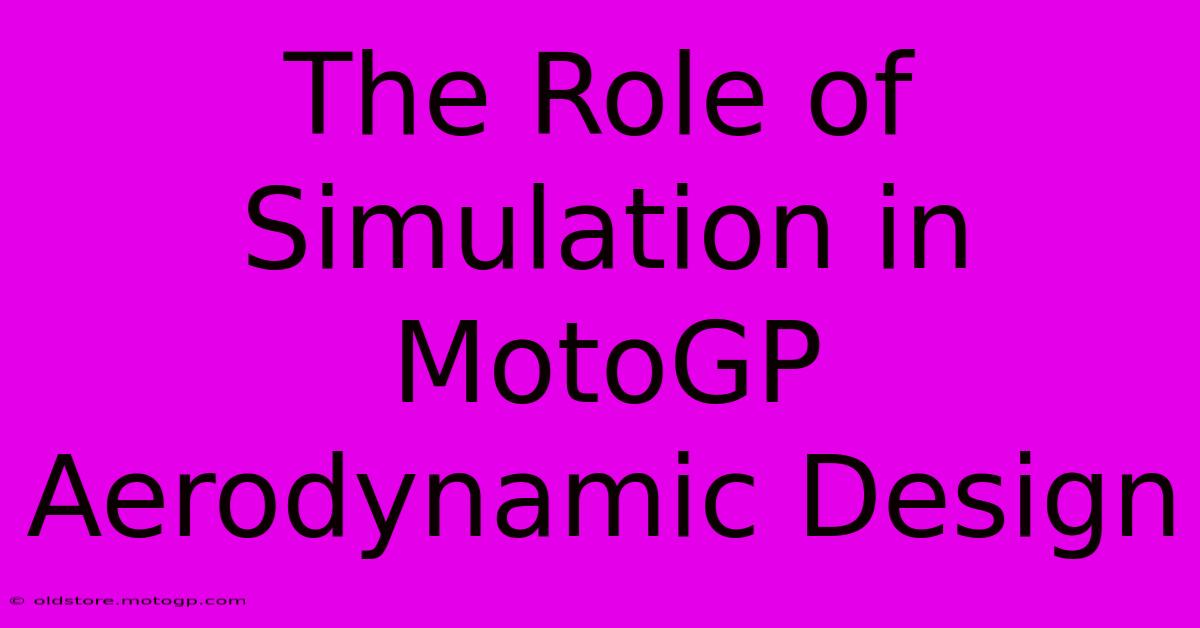The Role Of Simulation In MotoGP Aerodynamic Design

Table of Contents
The Role of Simulation in MotoGP Aerodynamic Design
The roar of the engines, the lean of the bikes, the breathtaking speeds – MotoGP is a spectacle of precision and power. Behind the thrilling races and fierce competition lies a world of meticulous engineering, where aerodynamic design plays a crucial role. And increasingly, sophisticated simulations are becoming the cornerstone of this design process. This article delves into how simulation is revolutionizing aerodynamic development in MotoGP, offering teams a competitive edge in this fiercely contested championship.
From Wind Tunnels to Virtual Reality: The Evolution of Aerodynamic Testing
Traditionally, MotoGP teams relied heavily on wind tunnel testing to assess the aerodynamic performance of their machines. While wind tunnels remain a vital tool, they are expensive, time-consuming, and inherently limited. They offer a snapshot of performance under specific, controlled conditions, often failing to capture the complexities of real-world racing scenarios.
This is where computational fluid dynamics (CFD) simulation steps in. CFD uses powerful computers to solve complex equations governing fluid flow, allowing engineers to virtually test and refine designs in a fraction of the time and cost associated with wind tunnel experiments.
The Advantages of CFD Simulation in MotoGP Aerodynamics
- Speed and Efficiency: Simulations can be run much faster than physical wind tunnel tests, allowing for rapid iteration and optimization of designs. This is particularly crucial in the fast-paced world of MotoGP, where constant development is key.
- Cost-Effectiveness: While the initial investment in software and computing power is significant, CFD simulation ultimately reduces the overall cost of aerodynamic development compared to extensive wind tunnel testing.
- Detailed Analysis: Simulations provide a wealth of data on airflow patterns, pressure distribution, and other crucial aerodynamic parameters. This level of detail is invaluable for understanding how design changes impact performance.
- Exploration of Extreme Conditions: CFD allows for the simulation of extreme conditions like different track layouts, varying speeds, and even rider movements, providing a more comprehensive understanding of aerodynamic performance.
- Improved Collaboration: Simulation data can be easily shared and analyzed by engineers across different teams and departments, fostering better collaboration and design optimization.
Key Applications of Simulation in MotoGP Aerodynamics
Simulation is used across various aspects of MotoGP aerodynamic design, including:
- Fairing Design: Optimizing the shape and configuration of the fairing to minimize drag and maximize downforce is critical. Simulation helps engineers explore numerous fairing designs, identifying the most efficient configurations.
- Winglet Design: The complex interplay of winglets and their impact on airflow is intricately modeled through simulation. Engineers can analyze the effects of different winglet shapes, sizes, and placements to fine-tune downforce and stability.
- Rider Interaction: Simulations accurately capture the aerodynamic interaction between the bike and the rider. This enables engineers to design bikes that minimize drag and improve stability, considering the rider's position and movements.
- Cooling System Optimization: Airflow around the engine and other components is crucial for efficient cooling. Simulations help to optimize cooling systems, ensuring peak performance while minimizing drag.
The Future of Simulation in MotoGP Aerodynamics
As computing power continues to increase and simulation software becomes more sophisticated, the role of simulation in MotoGP aerodynamic design will only become more significant. We can expect to see:
- Increased Accuracy: Advances in computational methods and meshing techniques will lead to even more accurate simulations, bridging the gap between virtual and real-world performance.
- Integration of Machine Learning: Machine learning algorithms can be used to analyze simulation data and optimize designs automatically, leading to faster and more efficient development cycles.
- Virtual Wind Tunnels: The integration of virtual reality and augmented reality technologies into simulations will provide engineers with more intuitive and immersive design tools.
In conclusion, simulation is no longer a luxury but a necessity in the pursuit of aerodynamic excellence in MotoGP. By leveraging the power of CFD and other simulation techniques, teams can push the boundaries of performance, leading to faster lap times and ultimately, victory on the track. The future of MotoGP is inextricably linked to the continued advancement of simulation technology.

Thank you for visiting our website wich cover about The Role Of Simulation In MotoGP Aerodynamic Design. We hope the information provided has been useful to you. Feel free to contact us if you have any questions or need further assistance. See you next time and dont miss to bookmark.
Featured Posts
-
Cota Transportation Save Time And Energy
Feb 24, 2025
-
The Moto Gp Qualifying Results A Preview Of The Thrills To Come
Feb 24, 2025
-
The Art Of Speed Explore Our Replica Helmet Collection
Feb 24, 2025
-
Lub Si Cota A Life Changing Experience
Feb 24, 2025
-
Experience The Power Of Racing Motorcycles
Feb 24, 2025
